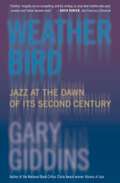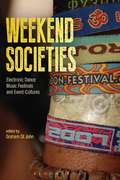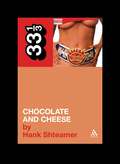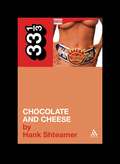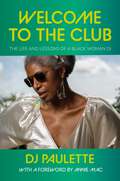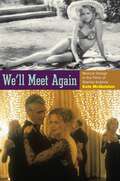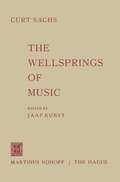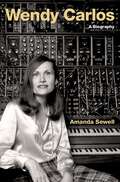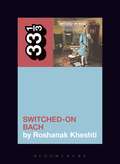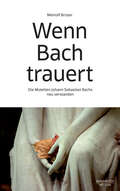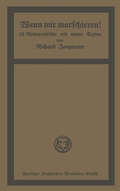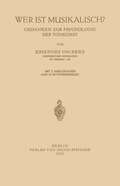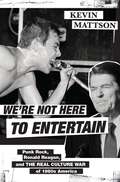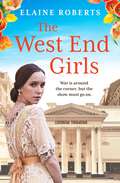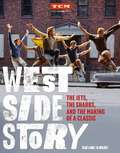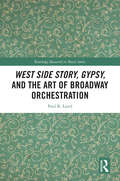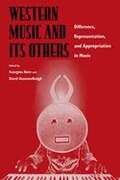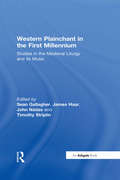- Table View
- List View
Weather Bird: Jazz at the Dawn of Its Second Century
by Gary GiddinsGary Giddins's Weather Bird is a brilliant companion volume to his landmark in music criticism, Visions of Jazz, winner of the National Book Critics Circle Award in Criticism. More then 140 pieces, written over a 14-year period, are brought together for the first time in this superb collection of essays, reviews, and articles. Weather Bird is a celebration of jazz, with illuminating commentaryon contemporary jazz events, today's top muscicians, the best records of the year, and on leading figures from jazz's past. Readers will find extended pieces on Louis Armstrong, Erroll Garner, Benny Carter, Sonny Rollins, Dave Brubeck, Ornette Coleman, Billie Holiday, Cassandra Wilson, Tony Bennett, and many others. Giddins includes a series of articles on the annual JVC Jazz Festival, which offers a splendid overview of jazz in the 1990s. Other highlights include an astute look at avant-garde music ("Parajazz") and his challenging essay, "How Come Jazz Isn't Dead?" which advances a theory about the way art is born, exploited, celebrated, and sidelined to the museum. A radiant compendium by America's leading music critic, Weather Bird offers an unforgettable look at the modern jazz scene.
Weather Bird: Jazz at the Dawn of Its Second Century
by Gary GiddinsGary Giddins's Weather Bird is a brilliant companion volume to his landmark in music criticism, Visions of Jazz, winner of the National Book Critics Circle Award in Criticism. More then 140 pieces, written over a 14-year period, are brought together for the first time in this superb collection of essays, reviews, and articles. Weather Bird is a celebration of jazz, with illuminating commentaryon contemporary jazz events, today's top muscicians, the best records of the year, and on leading figures from jazz's past. Readers will find extended pieces on Louis Armstrong, Erroll Garner, Benny Carter, Sonny Rollins, Dave Brubeck, Ornette Coleman, Billie Holiday, Cassandra Wilson, Tony Bennett, and many others. Giddins includes a series of articles on the annual JVC Jazz Festival, which offers a splendid overview of jazz in the 1990s. Other highlights include an astute look at avant-garde music ("Parajazz") and his challenging essay, "How Come Jazz Isn't Dead?" which advances a theory about the way art is born, exploited, celebrated, and sidelined to the museum. A radiant compendium by America's leading music critic, Weather Bird offers an unforgettable look at the modern jazz scene.
Weekend Societies: Electronic Dance Music Festivals and Event-Cultures
by Graham St JohnFrom massive raves sprouting around the London orbital at the turn of the 1990s to events operated under the control of corporate empires, EDM (Electronic Dance Music) festivals have developed into cross-genre, multi-city, transnational mega-events. From free party teknivals proliferating across Europe since the mid-1990s to colossal corporate attractions like Tomorrowland Electric Daisy Carnival and Stereosonic, and from transformational and participatory events like Burning Man and events in the UK outdoor psytrance circuit, to such digital arts and new media showcases as Barcelona's Sónar Festival and Montreal's MUTEK, dance festivals are platforms for a variety of arts, lifestyles, industries and policies.Growing ubiquitous in contemporary social life, and providing participants with independent sources of belonging, these festivals and their event-cultures are diverse in organization, intent and outcome. From ethically-charged and “boutique” events with commitments to local regions to subsidiaries of entertainment conglomerates touring multiple nations, EDM festivals are expressions of “freedoms” revolutionary and recreational. Centres of “EDM pop”, critical vectors in tourism industries, fields of racial distinction, or experiments in harm reduction, gifting culture, and co-created art, as this volume demonstrates, diversity is evident across management styles, performance legacies and modes of participation.Weekend Societies is a timely interdisciplinary volume from the emergent field of EDM festival and event-culture studies. Echoing an industry trend in world dance music culture from raves and clubs towards festivals, Weekend Societies features contributions from scholars of EDM festivals showcasing a diversity of methodological approaches, theoretical perspectives and representational styles.Organised in four sections: Dance Empires; Underground Networks; Urban Experiments; Global Flows, Weekend Societies illustrates how a complex array of regional, economic, social, cultural and political factors combine to determine the fate of EDM festivals that transpire at the intersections of the local and global.
Weekend Societies: Electronic Dance Music Festivals and Event-Cultures
by Graham St JohnFrom massive raves sprouting around the London orbital at the turn of the 1990s to events operated under the control of corporate empires, EDM (Electronic Dance Music) festivals have developed into cross-genre, multi-city, transnational mega-events. From free party teknivals proliferating across Europe since the mid-1990s to colossal corporate attractions like Tomorrowland Electric Daisy Carnival and Stereosonic, and from transformational and participatory events like Burning Man and events in the UK outdoor psytrance circuit, to such digital arts and new media showcases as Barcelona's Sónar Festival and Montreal's MUTEK, dance festivals are platforms for a variety of arts, lifestyles, industries and policies.Growing ubiquitous in contemporary social life, and providing participants with independent sources of belonging, these festivals and their event-cultures are diverse in organization, intent and outcome. From ethically-charged and “boutique” events with commitments to local regions to subsidiaries of entertainment conglomerates touring multiple nations, EDM festivals are expressions of “freedoms” revolutionary and recreational. Centres of “EDM pop”, critical vectors in tourism industries, fields of racial distinction, or experiments in harm reduction, gifting culture, and co-created art, as this volume demonstrates, diversity is evident across management styles, performance legacies and modes of participation.Weekend Societies is a timely interdisciplinary volume from the emergent field of EDM festival and event-culture studies. Echoing an industry trend in world dance music culture from raves and clubs towards festivals, Weekend Societies features contributions from scholars of EDM festivals showcasing a diversity of methodological approaches, theoretical perspectives and representational styles.Organised in four sections: Dance Empires; Underground Networks; Urban Experiments; Global Flows, Weekend Societies illustrates how a complex array of regional, economic, social, cultural and political factors combine to determine the fate of EDM festivals that transpire at the intersections of the local and global.
Ween's Chocolate and Cheese (33 1/3)
by Hank ShteamerWeen now seems like a permanent fixture on the pop-cultural landscape, but when the band first hit MTV in the early '90s, their longevity wasn't so secure. Nearly two decades on, though, Aaron "Gene Ween" Freeman and Mickey "Dean Ween" Melchiondo preside over one of the most devoted cult fan bases in American music. So how exactly did Ween manage to transcend joke-band oblivion?One answer is that, in the years following their MTV breakthrough, Ween gradually polished their output, turning their staunchly primitive musical sketches into hi-fi paintings. Chocolate and Cheese, released in 1994, marked Freeman and Melchiondo's first crucial steps in this direction. Based on new, in-depth interviews with both members of Ween, as well as producer Andrew Weiss and associates ranging from Josh Homme (Queens of the Stone Age) to Spike Jonze, this book explores the song-by-song creation of Chocolate and Cheese and how the album served as a bridge between Ween's original two-guys-and-a-4-track incarnation and the rich, virtuosic rock & roll force they would later become.
Ween's Chocolate and Cheese (33 1/3)
by Hank ShteamerWeen now seems like a permanent fixture on the pop-cultural landscape, but when the band first hit MTV in the early '90s, their longevity wasn't so secure. Nearly two decades on, though, Aaron "Gene Ween" Freeman and Mickey "Dean Ween" Melchiondo preside over one of the most devoted cult fan bases in American music. So how exactly did Ween manage to transcend joke-band oblivion?One answer is that, in the years following their MTV breakthrough, Ween gradually polished their output, turning their staunchly primitive musical sketches into hi-fi paintings. Chocolate and Cheese, released in 1994, marked Freeman and Melchiondo's first crucial steps in this direction. Based on new, in-depth interviews with both members of Ween, as well as producer Andrew Weiss and associates ranging from Josh Homme (Queens of the Stone Age) to Spike Jonze, this book explores the song-by-song creation of Chocolate and Cheese and how the album served as a bridge between Ween's original two-guys-and-a-4-track incarnation and the rich, virtuosic rock & roll force they would later become.
Welcome to the club: The life and lessons of a Black woman DJ
by DJ PauletteIn Welcome to the club, Manchester legend DJ Paulette shares the highs, lows and lessons of a thirty-year music career, with help from some famous friends.One of the Haçienda’s first female DJs, Paulette has scaled the heights of the music industry, playing to crowds of thousands all around the world, and descended to the lows of being unceremoniously benched by COVID-19, with no chance of furlough and little support from the government. Here she tells her story, offering a remarkable view of the music industry from a Black woman’s perspective. Behind the core values of peace, love, unity and respect, dance music is a world of exclusion, misogyny, racism and classism. But, as Paulette reveals, it is also a space bursting at the seams with powerful women.Part personal account, part call to arms, Welcome to the club exposes the exclusivity of the music industry while seeking to do justice to the often invisible women who keep the beat going.
Welcome to the club: The life and lessons of a Black woman DJ
by DJ PauletteIn Welcome to the club, Manchester legend DJ Paulette shares the highs, lows and lessons of a thirty-year music career, with help from some famous friends.One of the Haçienda’s first female DJs, Paulette has scaled the heights of the music industry, playing to crowds of thousands all around the world, and descended to the lows of being unceremoniously benched by COVID-19, with no chance of furlough and little support from the government. Here she tells her story, offering a remarkable view of the music industry from a Black woman’s perspective. Behind the core values of peace, love, unity and respect, dance music is a world of exclusion, misogyny, racism and classism. But, as Paulette reveals, it is also a space bursting at the seams with powerful women.Part personal account, part call to arms, Welcome to the club exposes the exclusivity of the music industry while seeking to do justice to the often invisible women who keep the beat going.
We'll Meet Again: Musical Design in the Films of Stanley Kubrick (Oxford Music / Media)
by Kate McQuistonUnique and often startling encounters between music and the moving image in the films of Stanley Kubrick are trademarks of his style; witness the powerful effects of Strauss's "Also Sprach Zarathustra" in 2001: A Space Odyssey and of Beethoven's 9th Symphony in A Clockwork Orange, each excerpt vetted by Kubrick himself. We'll Meet Again argues that, for Kubrick, music is neither post-production afterthought nor background nor incidental, but instead is core to films' effects and meanings. The book first identifies the building blocks in Kubrick's sonic world and illuminates the ways in which Kubrick uses them to support his characters and to define character relationships. It then delves into the effects of Kubrick's signature musical techniques, including the use of texture, form, and inscription to render and reinforce psychological ideas and spectator responses. Finally it presents case studies that show how the history of the music plays a vital and dynamic role for the films. As a whole, the book locates Kubrick as a force in music reception history by examining the relationship between his musical choices and popular culture, and reveals the foundational role of music in his filmmaking.
Wendy Carlos: A Biography (Cultural Biographies)
by Amanda SewellWith her debut album Switched-On Bach, composer and electronic musician Wendy Carlos (b. 1939) brought the sound of the Moog synthesizer to a generation of listeners, helping to effect arguably one of the most substantial changes in popular music's sound since musicians began using amplifiers. Her story is not only one of a person who blazed new trails in electronic music for decades but is also the story of a person who intersected in many ways with American popular culture, medicine, and social trends during the second half of the 20th century and well into the 21st. There is much to tell about her life and about the ways in which her life reflects many dimensions of American culture. Carlos's identity as a transgender woman has shaped many aspects of her life, her career, how she relates to the public, and how the public has received her and her music. Cultural factors surrounding the treatment of transgender people affected many of the decisions that Carlos has made over the decades. Additionally, cultural reception and perception of transgender people has colored how journalists, scholars, and fans have written about Carlos and her music for decades.
Wendy Carlos: A Biography (Cultural Biographies)
by Amanda SewellWith her debut album Switched-On Bach, composer and electronic musician Wendy Carlos (b. 1939) brought the sound of the Moog synthesizer to a generation of listeners, helping to effect arguably one of the most substantial changes in popular music's sound since musicians began using amplifiers. Her story is not only one of a person who blazed new trails in electronic music for decades but is also the story of a person who intersected in many ways with American popular culture, medicine, and social trends during the second half of the 20th century and well into the 21st. There is much to tell about her life and about the ways in which her life reflects many dimensions of American culture. Carlos's identity as a transgender woman has shaped many aspects of her life, her career, how she relates to the public, and how the public has received her and her music. Cultural factors surrounding the treatment of transgender people affected many of the decisions that Carlos has made over the decades. Additionally, cultural reception and perception of transgender people has colored how journalists, scholars, and fans have written about Carlos and her music for decades.
Wendy Carlos's Switched-On Bach (33 1/3)
by Roshanak KheshtiSo much, popular and scholarly, has been written about the synthesizer, Bob Moog and his brand-name instrument, and even Wendy Carlos, the musician who made this instrument famous. No one, however, has examined the importance of spy technology, the Cold War and Carlos's gender to this critically important innovation. Through a postcolonial lens of feminist science and technology studies, Roshanak Kheshti engages in a reading of Carlos's music within this gendered context. By focusing on Switched-On Bach (the highest selling classical music recording of all time), this book explores the significance of gender to the album's--and, as a result, the Moog synthesizer's--phenomenal success.
Wendy Carlos's Switched-On Bach (33 1/3 #141)
by Roshanak KheshtiSo much, popular and scholarly, has been written about the synthesizer, Bob Moog and his brand-name instrument, and even Wendy Carlos, the musician who made this instrument famous. No one, however, has examined the importance of spy technology, the Cold War and Carlos's gender to this critically important innovation. Through a postcolonial lens of feminist science and technology studies, Roshanak Kheshti engages in a reading of Carlos's music within this gendered context. By focusing on Switched-On Bach (the highest selling classical music recording of all time), this book explores the significance of gender to the album's--and, as a result, the Moog synthesizer's--phenomenal success.
Wenn Bach trauert: Die Motetten Johann Sebastian Bachs neu verstanden
by Meinolf BrüserMeinolf Brüsers Buch bietet eine völlig neue Sicht auf Bachs Motetten und auf Bach selbst. Bachs Motetten sind in ihrer historischen Entstehung für die Musikwissenschaft ein Rätsel geblieben. Sie galten bisher als bürgerliche Auftragsmusiken. Tatsächlich gelingt es, durch eingehende Analysen und eine akribische historische Untersuchung ihre wirklichen Kompositionsanlässe offenzulegen:- Keine der Motetten war eine bürgerliche Auftragsmusik, alle waren als Trauermusik persönlich und zum Teil gar familiär motiviert. - Einblicke sind zu gewinnen in die musikalischen und textlichen Mittel, mit denen Bach auf die Traueranlässe Bezug nahm. - Wir erlangen ein grundlegend neues Verständnis von den Motetten – auch mit Konsequenzen für die Aufführungspraxis. Brüsers Buch zeichnet ein verändertes Bild von Johann Sebastian Bach. Frei vom Bach-Bild des 19. Jahrhunderts und von Bachs theologischer Indienstnahme zeigt es ihn als Musiker und Komponisten in seinem persönlichen, ja privaten Handeln, in seinen Emotionen, seinem Reichtum an Fantasie, seinem Traditionsbewusstsein und nicht zuletzt in seinem Selbstverständnis als Musiker.
Wenn wir marschieren!: 16 Armeemärsche mit neuen Texten
by Richard ZoozmannDieser Buchtitel ist Teil des Digitalisierungsprojekts Springer Book Archives mit Publikationen, die seit den Anfängen des Verlags von 1842 erschienen sind. Der Verlag stellt mit diesem Archiv Quellen für die historische wie auch die disziplingeschichtliche Forschung zur Verfügung, die jeweils im historischen Kontext betrachtet werden müssen. Dieser Titel erschien in der Zeit vor 1945 und wird daher in seiner zeittypischen politisch-ideologischen Ausrichtung vom Verlag nicht beworben.
Wer ist Musikalisch?: Gedanken zur Psychologie der Tonkunst
by Johannes von KriesDieser Buchtitel ist Teil des Digitalisierungsprojekts Springer Book Archives mit Publikationen, die seit den Anfängen des Verlags von 1842 erschienen sind. Der Verlag stellt mit diesem Archiv Quellen für die historische wie auch die disziplingeschichtliche Forschung zur Verfügung, die jeweils im historischen Kontext betrachtet werden müssen. Dieser Titel erschien in der Zeit vor 1945 und wird daher in seiner zeittypischen politisch-ideologischen Ausrichtung vom Verlag nicht beworben.
We're Not Here to Entertain: Punk Rock, Ronald Reagan, and the Real Culture War of 1980s America
by Kevin MattsonMany remember the 1980s as the era of Ronald Reagan, a conservative decade populated by preppies and yuppies dancing to a soundtrack of electronic synth pop music. In some ways, it was the "MTV generation." However, the decade also produced some of the most creative works of punk culture, from the music of bands like the Minutemen and the Dead Kennedys to avant-garde visual arts, literature, poetry, and film. In We're Not Here to Entertain, Kevin Mattson documents what Kurt Cobain once called a "punk rock world" --the all-encompassing hardcore-indie culture that incubated his own talent. Mattson shows just how widespread the movement became--ranging across the nation, from D.C. through Ohio and Minnesota to LA--and how democratic it was due to its commitment to Do-It-Yourself (DIY) tactics. Throughout, Mattson puts the movement into a wider context, locating it in a culture war that pitted a blossoming punk scene against the new president. Reagan's talk about end days and nuclear warfare generated panic; his tax cuts for the rich and simultaneous slashing of school lunch program funding made punks, who saw themselves as underdogs, seethe at his meanness. The anger went deep, since punks saw Reagan as the country's entertainer-in-chief; his career, from radio to Hollywood and television, synched to the very world punks rejected. Through deep archival research, Mattson reignites the heated debates that punk's opposition generated in that era-about everything from "straight edge" ethics to anarchism to the art of dissent. By reconstructing the world of punk, Mattson demonstrates that it was more than just a style of purple hair and torn jeans. In so doing, he reminds readers of punk's importance and its challenge to simplistic assumptions about the 1980s as a one-dimensional, conservative epoch.
We're Not Here to Entertain: Punk Rock, Ronald Reagan, and the Real Culture War of 1980s America
by Kevin MattsonMany remember the 1980s as the era of Ronald Reagan, a conservative decade populated by preppies and yuppies dancing to a soundtrack of electronic synth pop music. In some ways, it was the "MTV generation." However, the decade also produced some of the most creative works of punk culture, from the music of bands like the Minutemen and the Dead Kennedys to avant-garde visual arts, literature, poetry, and film. In We're Not Here to Entertain, Kevin Mattson documents what Kurt Cobain once called a "punk rock world" --the all-encompassing hardcore-indie culture that incubated his own talent. Mattson shows just how widespread the movement became--ranging across the nation, from D.C. through Ohio and Minnesota to LA--and how democratic it was due to its commitment to Do-It-Yourself (DIY) tactics. Throughout, Mattson puts the movement into a wider context, locating it in a culture war that pitted a blossoming punk scene against the new president. Reagan's talk about end days and nuclear warfare generated panic; his tax cuts for the rich and simultaneous slashing of school lunch program funding made punks, who saw themselves as underdogs, seethe at his meanness. The anger went deep, since punks saw Reagan as the country's entertainer-in-chief; his career, from radio to Hollywood and television, synched to the very world punks rejected. Through deep archival research, Mattson reignites the heated debates that punk's opposition generated in that era-about everything from "straight edge" ethics to anarchism to the art of dissent. By reconstructing the world of punk, Mattson demonstrates that it was more than just a style of purple hair and torn jeans. In so doing, he reminds readers of punk's importance and its challenge to simplistic assumptions about the 1980s as a one-dimensional, conservative epoch.
The West End Girls: a heartwarming WW1 saga about love and friendship (The West End Girls Book 1) (The West End Girls #1)
by Elaine Roberts'A fabulous, uplifting tale of friendship at the heart of wartime' Fiona Ford on Christmas at the Foyles Bookshop. 1914. Growing up on a farm in the country, Annie Cradwell has always dreamt of singing on stage. So when she hears her friend Joyce has a room to spare in London, she sets off with best friend Rose for an adventure beyond anything they could have imagined. In London, Annie and Rose stumble into jobs at the Lyceum Theatre. Being a dresser to capricious star Kitty Smythe wasn't exactly what Annie had in mind. But then the musical director, Matthew Harris, offers her singing lessons. And Annie starts to wonder – could this be her chance? Or is it all too good to be true? With the threat of war in the air, everything is uncertain. Is there a place for hopes and dreams when so much is at stake? Annie, Rose and Joyce are three girls with very different dreams – but the same great friendship. From the author of the beloved Foyles Bookshop Girls series, The West End Girls is the first in a brand new series full of Elaine Roberts' trademark warmth. Perfect for fans of Daisy Styles and Rosie Hendry.
West Side Story: The Jets, the Sharks, and the Making of a Classic (Turner Classic Movies)
by Richard BarriosA captivating, richly illustrated full account of the making of the ground-breaking movie classic West Side Story (1961).A major hit on Broadway, on film West Side Story became immortal-a movie different from anything that had come before, but this cinematic victory came at a price. In this engrossing volume, film historian Richard Barrios recounts how the drama and rivalries seen onscreen played out to equal intensity behind-the-scenes, while still achieving extraordinary artistic feats.The making and impact of West Side Story has so far been recounted only in vestiges. In the pages of this book, the backstage tale comes to life along with insight on what has made the film a favorite across six decades: its brilliant use of dance as staged by erstwhile co-director Jerome Robbins; a meaningful story, as set to Leonard Bernstein and Stephen Sondheim's soundtrack; the performances of a youthful ensemble cast featuring Natalie Wood, Rita Moreno, George Chakiris, and more; a film with Shakespearean roots (Romeo and Juliet) that is simultaneously timeless and current. West Side Story was a triumph that appeared to be very much of its time; over the years it has shown itself to be eternal.
West Side Story, Gypsy, and the Art of Broadway Orchestration (Routledge Research in Music)
by Paul LairdIn this ground-breaking study, Paul Laird examines the process and effect of orchestration in West Side Story and Gypsy, two musicals that were among the most significant Broadway shows of the 1950s, and remain important in the modern repertory. Drawing on extensive archival research with original manuscripts, Laird provides a detailed account of the process of orchestration for these musicals, and their context in the history of Broadway orchestration. He argues that the orchestration plays a vital role in the characterization and plot development in each major musical number, opening a new avenue for analysis that deepens our understanding of the musical as an art form. The orchestration of the score in Broadway musicals deeply shapes their final soundscapes, but only recently has it begun to receive real attention. Linked by a shared orchestrator, in other ways West Side Story and Gypsy offer a study in contrasts. Breaking down how the two composers, Leonard Bernstein and Jules Styne, collaborated with orchestrators Sid Ramin, Irwin Kostal, and Robert Ginzler, Laird’s study enables us to better understand both of these two iconic shows, and the importance of orchestration within musical theatre in general.
West Side Story, Gypsy, and the Art of Broadway Orchestration (Routledge Research in Music)
by Paul LairdIn this ground-breaking study, Paul Laird examines the process and effect of orchestration in West Side Story and Gypsy, two musicals that were among the most significant Broadway shows of the 1950s, and remain important in the modern repertory. Drawing on extensive archival research with original manuscripts, Laird provides a detailed account of the process of orchestration for these musicals, and their context in the history of Broadway orchestration. He argues that the orchestration plays a vital role in the characterization and plot development in each major musical number, opening a new avenue for analysis that deepens our understanding of the musical as an art form. The orchestration of the score in Broadway musicals deeply shapes their final soundscapes, but only recently has it begun to receive real attention. Linked by a shared orchestrator, in other ways West Side Story and Gypsy offer a study in contrasts. Breaking down how the two composers, Leonard Bernstein and Jules Styne, collaborated with orchestrators Sid Ramin, Irwin Kostal, and Robert Ginzler, Laird’s study enables us to better understand both of these two iconic shows, and the importance of orchestration within musical theatre in general.
Western Music and its Others (PDF): Difference, Representation, and Appropriation in Music
by Georgina Born David HesmondhalghThis innovative collection of articles offers a major comprehensive overview of new developments in cultural theory as applied to Western music. Addressing a broad range of primarily twentieth-century music, the authors examine two related phenomena: musical borrowings or appropriations, and how music has been used to construct, evoke, or represent difference of a musical or a sociocultural kind. The essays scrutinize a diverse body of music and discuss a range of significant examples, among them musical modernism's idealizing or ambivalent relations with popular, ethnic, and non-Western music; exoticism and orientalism in the experimental music tradition; the representation of others in Hollywood film music; music's role in the formation and contestation of collective identities, with reference to Jewish and Turkish popular music; and issues of representation and difference in jazz, world music, hip hop, and electronic dance music. Written by leading scholars from disciplines including historical musicology, sociology, ethnomusicology, anthropology, popular music studies, and film studies, the essays provide unprecedented insights into how cultural identities and differences are constructed in music.
Western Plainchant in the First Millennium: Studies in the Medieval Liturgy and its Music
by Sean GallagherTaking up questions and issues in early chant studies, this volume of essays addresses some of the topics raised in James McKinnon's The Advent Project: The Later Seventh-Century Creation of the Roman Mass, the last book before his untimely death in February 1999. A distinguished group of chant scholars examine the formation of the liturgy, issues of theory and notation, and Carolingian and post-Carolingian chant. Special studies include the origins of musical notations, nuances of early chant performance (with accompanying CD), musical style and liturgical structure in the early Divine Office, and new sources for Old-Roman chant. Western Plainchant in the First Millenium offers new information and new insights about a period of crucial importance in the growth of the liturgy and music of the Western Church.
